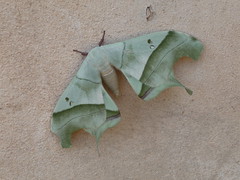I had an interesting conversation with a volunteer from an aid organization that works with indigenous peoples in Paraguay that I think is worth repeating here. Recently the Ache were awarded the title to Finca 470, land the Paraguayan government had guaranteed for the Ache by signing international agreements. (For the background on the Ache land struggle see here and here.) One of the pretexts that the Paraguayan government used to delay the transfer of the land to the Ache was that a group of Ava Guarani also had a claim to the Finca 470 land, and that the Ava Guarani would also have to be included in the land transfer negotiations. There was some controversy after the Ache were awarded their land, because the Ava Guarani were not included in the discussion.
The Ava Guarani claim does not seem to have any weight to me. The Finca 470 land is located in the heart of traditional Ache territory. The five Ava Guarani families who lived on the finca in 2005 settled there after the Ache community of Kue Tuvy was founded there, and the Ava Guarani occupied their houses on a temporary basis. The Ache occupied Finca 470 in accordance with a written agreement they had with SEAM (the Ministry of the Environment, which held ownership of the land), that promised the land title would be turned over to them in the future.
The aforementioned volunteer told me about a couple of arguments that people were using to justify the Ava Guarani claims:
(1) The land was set aside for indigenous peoples, and because the Ava Guarani are also indigenous, they also have a right to this land.
Indigenous peoples are not all the same and cannot be lumped together to suit the administrative purposes of the government. The idea that just any indigenous person can lay a claim to the traditional territory of another indigenous person, because they are both indigenous, is problematic. Paraguay is home to 17 indigenous ethnic groups belonging to several language families. These groups have their own social and cultural practices, and their own unique histories.
The agreements that set this land aside referred particularly to the Ache. The agreements also specified that the land should be conserved to be used for traditional hunting and gathering practices – practices of the Ache, and not the Ava Guarani, who are horticulturalists.
(2) The Ache live by hunting and fishing, while the Ava Guarani are horticulturalists. They occupy different ecological niches, so they can occupy the same land without interfering with each others’ livelihoods.
Human ecology doesn’t work that way. In order to plant their crops, the Ava Guarani would need to cut down the forest. The forest is home to the animals that the Ache hunt – if their forest habitat is heavily disturbed, the animals will go elsewhere.
Furthermore, this land was specially set aside for conservation, and the virgin forests were to be maintained so that the Ache could pursue their traditional way of life. The Ache have played an active role in the management and defense of the forest on Finca 470, as well as in the neighbouring Mbaracayu Nature Reserve. The Ava Guarani have not, and their horticultural activities are counter to the purpose. There are also claims that the Ava Guarani have ‘given permission’ for illegal logging on Finca 470.
I am not saying that the Ava Guarani don’t deserve land – they do! Just not the land that has already been promised to the Ache. Land tenancy is a big problem in Paraguay, and not just for the Ache and the Ava Guarani. Many campesinos and other indigenous groups are also short on land. A lot of the land in Paraguay was sold cheaply to friends of Alfredo Stroessner during his dictatorship (1954-1989). 10% of the population controls 66% of the land, and 30% of the rural population is landless (Mario, Silva-Leander, and Carter 2004).

An indigenous group (not Ache or Ava Guarani) camped out in a plaza in Asuncion to protest for land rights (July 2009)
Surely there are other parcels of land that are of better size for splitting. It’s like the Paraguayan government said, ‘Hey, we’ve got a lot of indigenous communities clamouring for land. Since we’ve already promised this land to this one indigenous group, why don’t we just split it into smaller pieces and give a little bit to all of them.” That’s not good enough.
References Cited






Posted on May 13, 2011